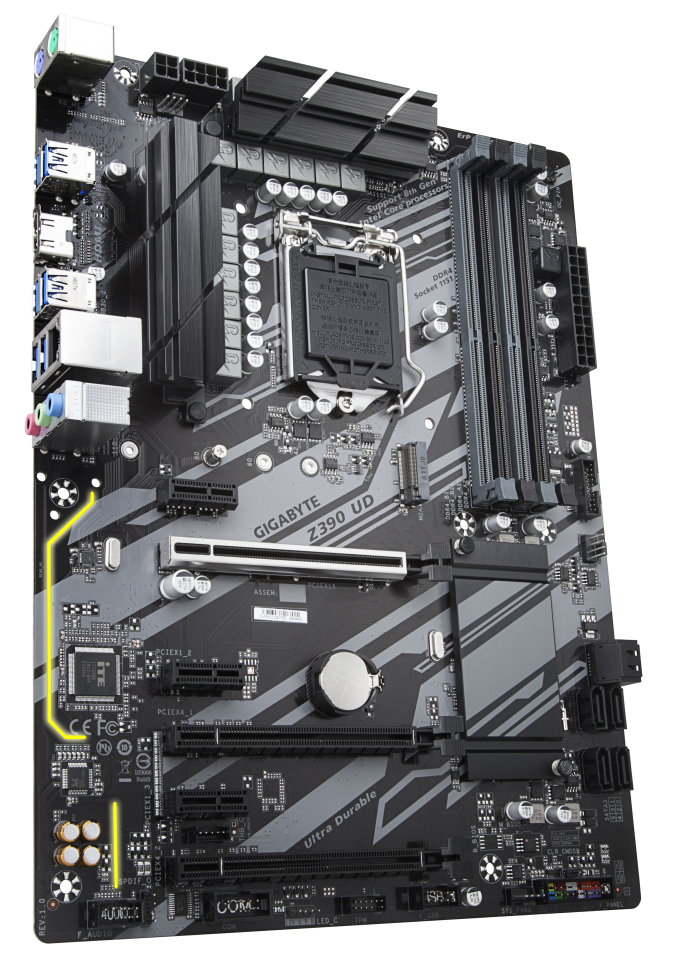Intel Z390 Motherboard Overview: 50+ Motherboards Analyzed
by Ian Cutress & Gavin Bonshor on October 8, 2018 10:53 AM EST- Posted in
- Motherboards
- Intel
- MSI
- Gigabyte
- ASRock
- EVGA
- Asus
- NZXT
- Supermicro
- Z390
GIGABYTE Z390 UD (Ultra Durable)
The GIGABYTE Z390 UD or Z390 Ultra Durable motherboard is ATX in size and drops all of the gaming branding and fluff associated with that for a cleaner and basic looking board. The black PCB has grey side sweeping straight patterning across the majority and combines it with the chipset heatsink. The board has a total of three full-length PCIe 3.0 slots with the top slot which is covered in metal slot protection supporting x16 and the two other bare full-length slots operating at x4; the board also features three PCIe 3.0 x1 slots. The board also has the same 8 and 4-pin 12V ATX power inputs as the Z390 Gaming SLI, Z390 Gaming X and Z390M Gaming models.
Storage wise the Z390 UD has a total of six SATA ports which are comprised of two right-angled connectors, with another bank of four featuring straight-angle connectors sitting just below. Above the PCIe slots is a single M.2 slot which supports both PCIe 3.0 x4 and SATA drives. For the memory up to a total of 64 GB can be installed across the four available RAM slots, with official XMP profiling currently being unannounced.
On the rear panel of the Z390 UD is a total of six USB 3.0 Type-A ports, a pair of PS/2 ports for a keyboard and mouse and an HDMI video output. This board drops any USB 3.1 Gen2 connectivity to shave on costs and isn't just the only GIGABYTE board to do so, but it's also using a cheaper Realtek ALC887 audio codec and Realtek RTL8111H Gigabit networking controller to power three 3.5 mm audio jacks and the single LAN port.
Without much pizazz and the gaming designed feature set, the Z390 UD (Ultra Durable) is targeted more towards budget systems and more professional users who aren't looking to spend extra budget on features deemed unnecessary which may for all intents and purposes remain unused. The Z390 UD costs $130 and as it stands, is the cheapest offering from GIGABYTE on Z390 as it represents one of the more modest entry-level Z390 offerings from any of the motherboard vendors at launch.












79 Comments
View All Comments
Smell This - Tuesday, October 9, 2018 - link
Much.Of.
The.
Same.
2 HSIO lanes per Gen 2 port and WiFi. Wow (rolling I-eyeballs) ...
MadAd - Tuesday, October 9, 2018 - link
58 motherboards, only 13 of which are smaller than ATX. When on earth are we going to move off this outdated oversized format? Its just more of the same every time, so depressing.gavbon - Wednesday, October 10, 2018 - link
13 is better than 0, or 12 :DMadAd - Wednesday, October 10, 2018 - link
Considering very small form formats (ITX) are harder to build for and only 7 are uATX, a size which is the most useful to transition away from ATX then no, it feels like an afterthought from a lazy industry. I mean who uses more than 1 main video card and 2-4 sticks of ram in a gaming PC these days? Even water builds into uATX isnt that hard to accomplish.After literally decades ATX should be a choice for edge cases not a mainstream build.
shaolin95 - Monday, October 22, 2018 - link
who cares about midge boards!Edkiefer - Wednesday, October 10, 2018 - link
All these MB with 2x 8 pin power inputs, is both mandatory and if so I guess new PSU will need 2x 8pin now.entity279 - Wednesday, October 10, 2018 - link
so it's ok to just buy SM motherboards now with them being involved in a security scandal?gavbon - Thursday, October 11, 2018 - link
I currently have the Supermicro C9Z390-PGW awaiting to go on the test bench next week, so from a consumers standpoint, I could potentially shed light on that board. As far as the Chinese/Supermicro/Spy scandal goes, I don't want to speculate without the finer details.eastcoast_pete - Wednesday, October 10, 2018 - link
Ian & Gavin, thanks for the overview.@ both - Question: I've read that Intel, to deal with its bad planning/capacity problems on 14 nm, has contracted the fabbing of some of its chipsets out to TSMC, specifically in TSMC's 22 nm tech. Is that correct, and did you have a chance to confirm that the new 390s used by these boards are indeed made by Intel on their 14 nm FinFET tech, or are they made by a contractor (TSMC)?
DanNeely - Wednesday, October 10, 2018 - link
AFAIK the chipsets being reverted to 22nm are using Intel's 22nm process in old unupgraded fabs. Doing so would be far less work than porting to a process from a different company; the latter would require massive rework to follow a completely different set of design rules.